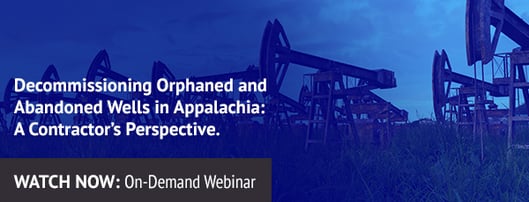Back on June 8, our own Luke and Steve Plants put on a live webinar called “Plugging Abandoned Wells in Appalachia: A Contractor’s Perspective.” In it, they discussed some of the issues faced by companies during P&A projects in this area, and how Plants & Goodwin typically works around these issues.
That webinar received over 100 registrations and was attended by 75 individuals, including many from state and local governments. This tells us there’s an audience for this information, so we’d like to make sure more people see it.

Below is an overview of the information we covered in our live webinar, including typical well-plugging challenges in Appalachia and the strategies our experts use to navigate around them. We still recommend you check out the webinar, which is available on demand now. But if you’re more of a reader, we hope you’ll take something away from the info we’re sharing here.
Now, onto the challenges.
Site Access
There’s a reason that companies have more trouble plugging wells in Appalachia than anywhere else. Forgive us this pun, but the region is not always well suited for these sites in the first place. Geography, weather, and infrastructure expansion all present unique challenges for those who install and maintain wells.
Where geography is concerned, the Appalachian Basin is mountainous, heavily forested and full of streams, creeks, lakes and rivers. These naturally occurring features can often impact the types of plugging equipment that can be used during a project, and will slow down a project if the plugging company isn’t prepared to navigate around them.
Weather can also throw a wrench into the best-laid plans. Frequent rain in the spring and fall will interfere with work, as will snow, ice and below-freezing temperatures in the winter.
And then there’s the infrastructure that may have appeared in the years since the well was first drilled. Roads, bridges and even buildings now sit near or on top of abandoned well sites. This can make accessing the well much more difficult.
At Plants & Goodwin, we’ve made ourselves more mobile and versatile to overcome these obstacles. For example, we use composite crane mats instead of the more common timber mats, as the mats are twice as efficient to move and do less damage to the site. We also utilize wheeled equipment that can be moved around in tight spaces. This helps us get even closer to the well without dragging equipment or otherwise altering the surrounding landscape.
Well Issues
In the vast majority of cases, plugging an abandoned well requires reaching its TVD — true vertical depth. You won’t encounter issues with this quite as often outside Appalachia, but inside, a host of issues could await to make your plugging project a bit more complicated.
Uncemented casings are one trouble spot for orphaned wells in the region. This likely comes down to age. The older a well is, the less likely it is that the drilling company employed best practices when creating it. Because this lack of cementing leaves the integrity of the surrounding formation compromised, cave-ins are a common occurrence.
Downhole obstructions may also thwart your ability to get started. These can be anything: from cave-in debris to rocks jutting out of the earth to trash thrown down the hole. If such obstructions are blocking your ability to reach the well’s TVD, they’ll need to be dealt with first.
In these types of scenarios, Plants & Goodwin operates on a strict model of risk mitigation. We determine unacceptable outcomes up front, engage local experts when possible to better understand the terrain, and hold frequent, highly focused meetings before and during the job.
We also go above and beyond to prioritize safety. It starts with well control, where we ensure trained supervisors are on site, BOP stacks or wellheads with rubber elements are present and ready to use, and casing integrity is confirmed. When feasible, we also hold ourselves to a two-barrier policy for added assurance.
Finally, we’re committed to meeting our ESG objectives and responsibilities. It’s our mission to do the least harm possible, which is why human safety comes first, followed by the protection of fresh water sources, then well integrity.
Complexities of the Stakeholder Network
The plug and abandonment space has many stakeholders with varying degrees of influence. These include landowners, nonprofits, researchers, military branches, government agencies and many more. With so many different individuals and organizations in the mix, it can be tough to know who to talk to about potential well plugging projects.
One of our strengths at Plants & Goodwin is our experience. For over 50 years, we’ve provided a number of well servicing solutions to our customers, including plug and abandonment services. Over that time, we’ve gotten to know our way around the stakeholder network and can help push your project forward.
Learn more about P&A in Appalachia
These are some of the more common challenges you’ll run into during plug and abandonment projects in the Appalachian region. If you’re interested in learning more from our team, watch our on-demand webinar. And if you’re interested in working with Plants & Goodwin on your next P&A project, reach out today.


